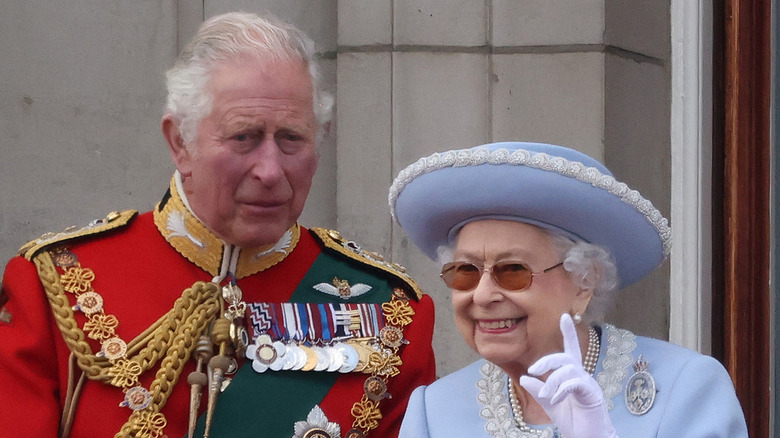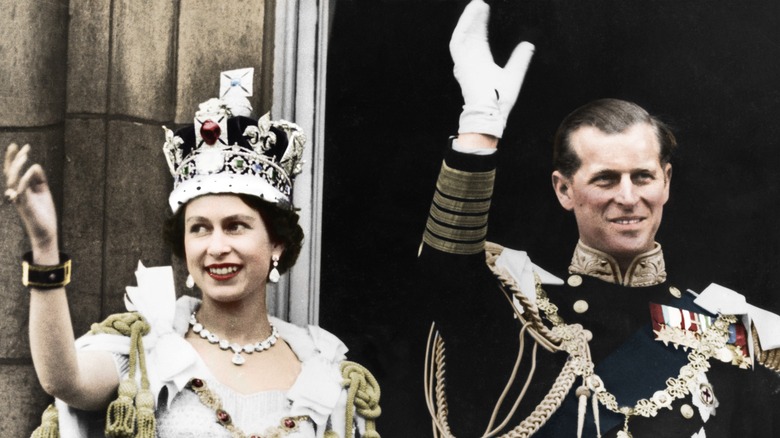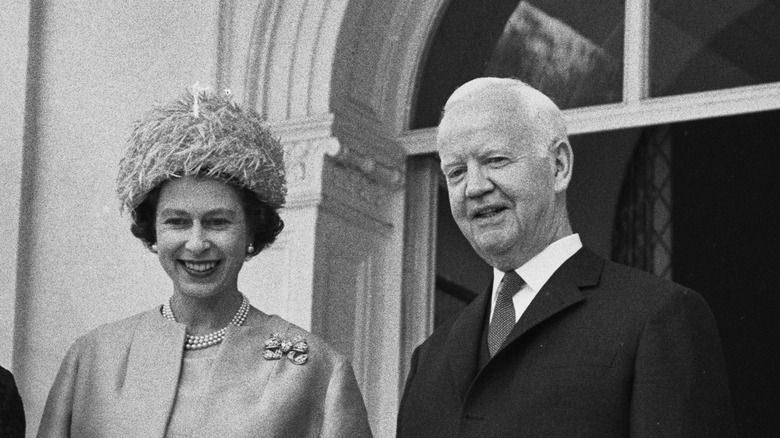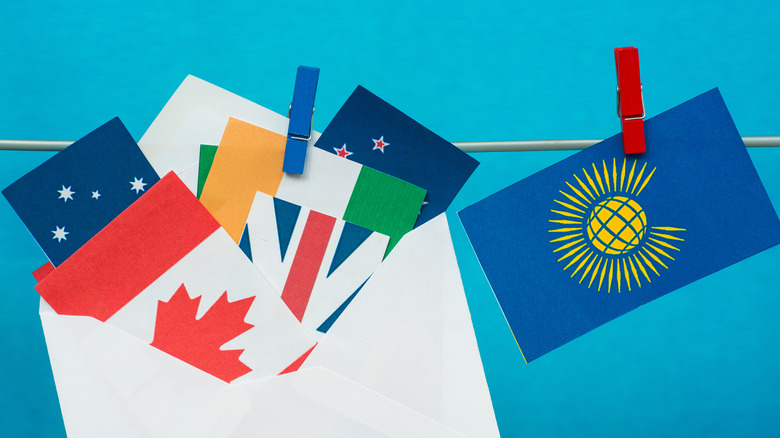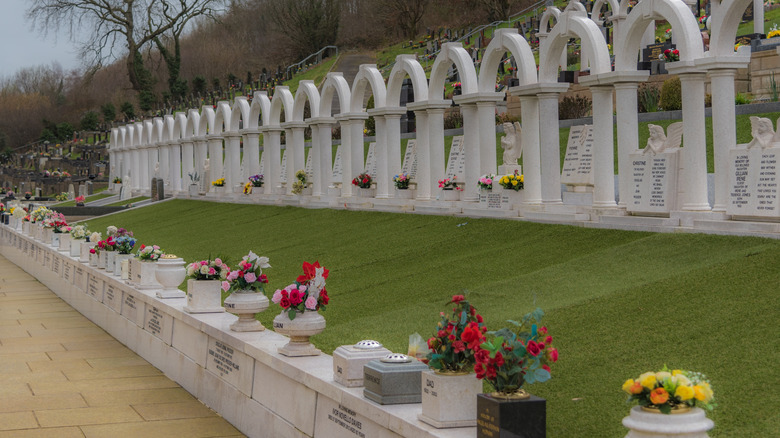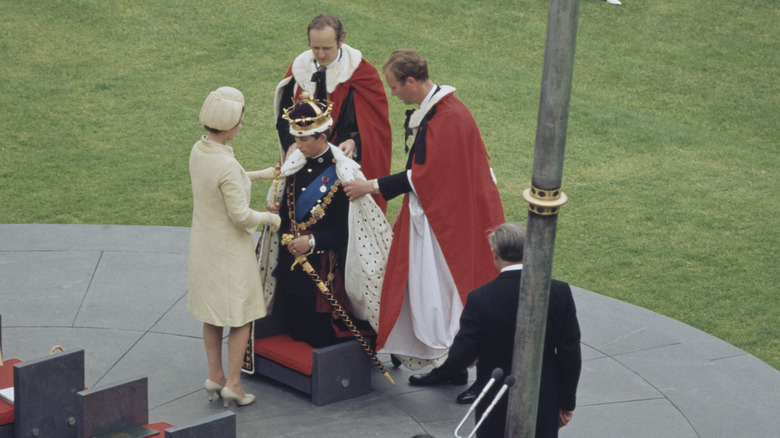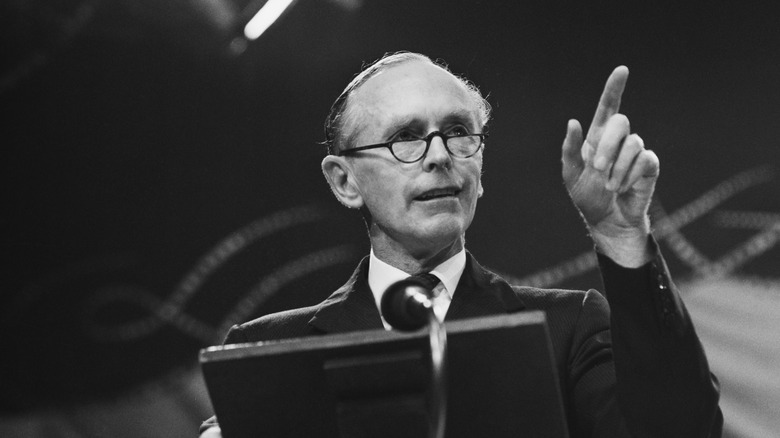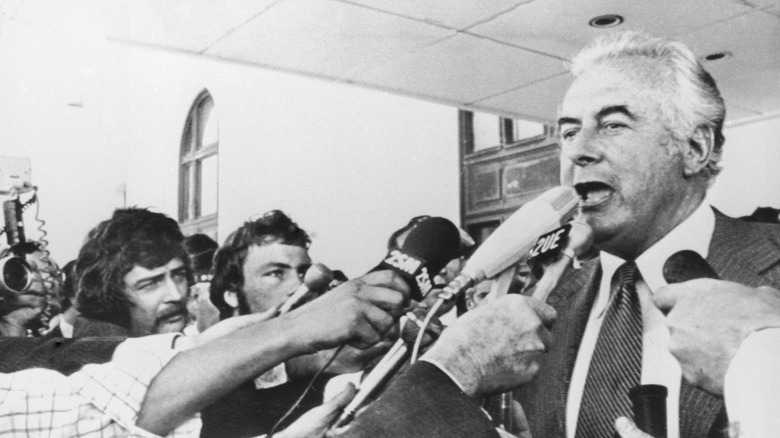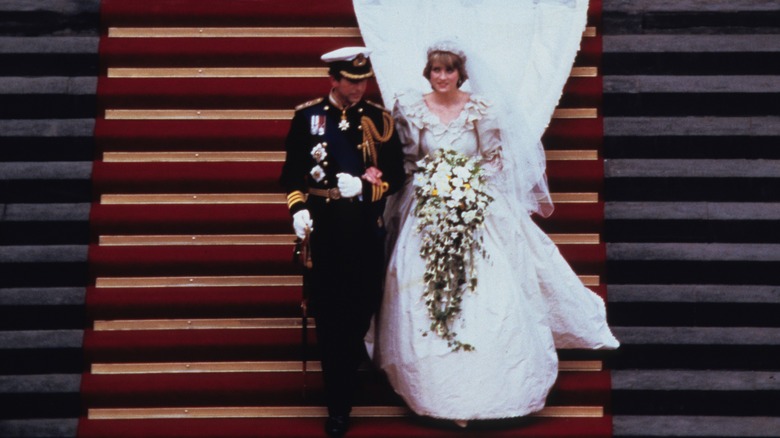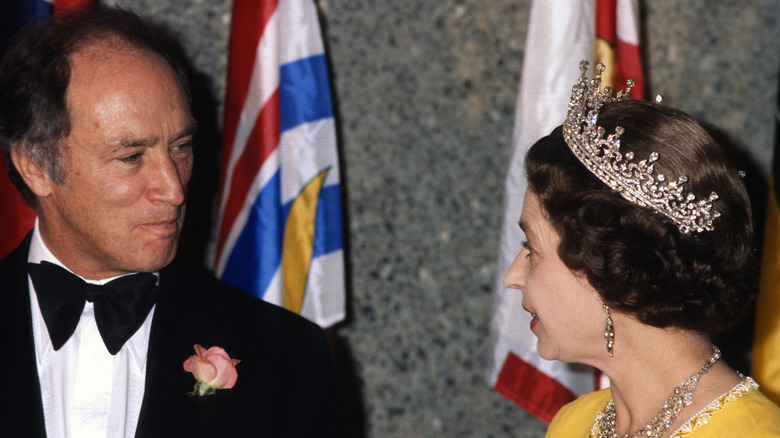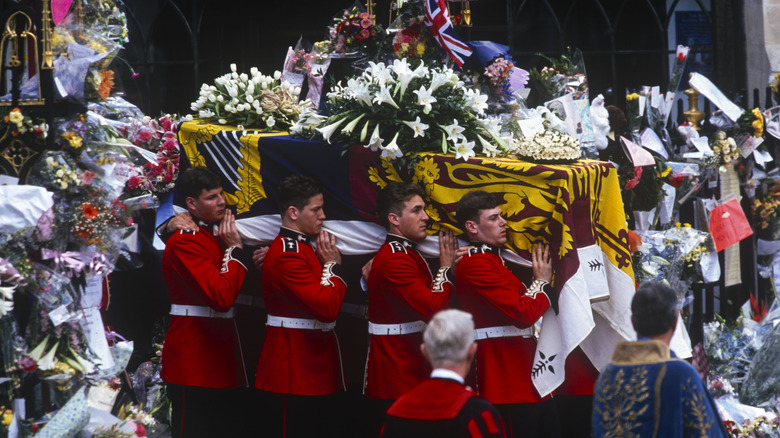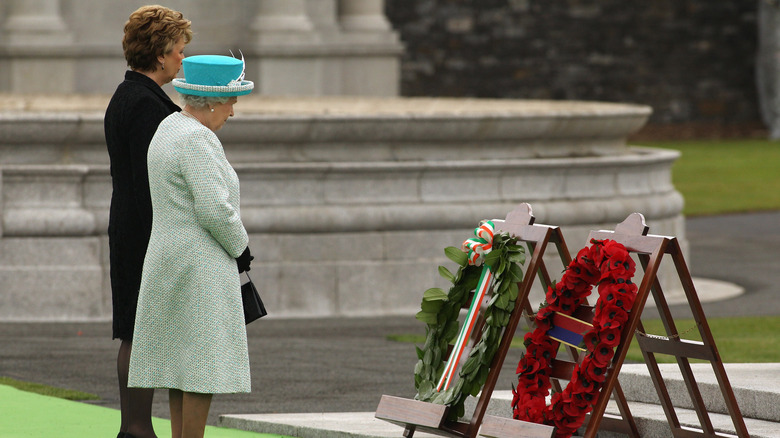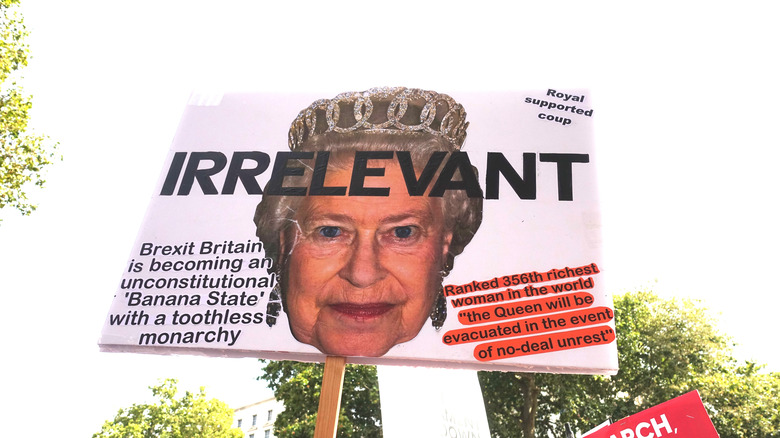The Most Notable Moments In Queen Elizabeth II's Reign
The United Kingdom without its current monarch is an inevitability, one that has seemed closer and more real in recent years. "Operation Transition" has been quietly advancing for several years (per The Guardian), but the COVID-19 pandemic and Queen Elizabeth II's own bout of COVID (and her declining mobility) have accelerated her delegating responsibilities to her son and heir, Prince Charles. It is a trend likely to continue until the day when the queen finally passes on.
Even with an ongoing preview of a post-Elizabethan world, however, it can be difficult to imagine a Britain without the queen. At 70 years on the throne, she is the only head of state within living memory for most Britons. Those years have seen multiple generations born and come of age, massive shifts in Britain's role on the world stage, changing cultural tides, personal triumphs and tragedies, and an evolution in the role of the monarchy itself. Throughout it all, the queen has persisted in her role, one that constitutional experts consider her very unlikely to yield up before death. Here is a look into just some of the moments that have shaped the reign of Elizabeth II.
Her unexpected coronation
Elizabeth II was not marked a queen from birth. Her father, Albert, Duke of York, was the second son of King George V (himself a second son, per Britannica). All expectations were that the throne would be inherited by Albert's brother Edward, and he did indeed become Edward VIII in 1936. As he had no children, however, Albert and Elizabeth remained his heirs. In the time he had to spend with her, George V doted on his granddaughter, according to the BBC, and predicted that she would come into the throne. He may have feared that Elizabeth would need to ascend at a young age as well; he felt sure his eldest son would give up the job, while Albert was not a healthy man.
George V's prediction for Edward VIII came true not even a full year out from his coronation. He abdicated the throne for the sake of his mistress, and Albert became King George VI. The health issues that had made his father worry — Buerger's disease, hardened arteries, lung cancer — were exacerbated by World War II (per TIME). He held the throne for 16 years, but by 1952, significant royal duties had been delegated to Elizabeth. She was standing in for her father on a diplomatic mission when she was told that her father had died, and she would be queen at age 25. Her coronation — the first one to be televised, per Royal.uk – took place the following year.
State visit to West Germany
Queen Elizabeth grew up under the shadow of the Second World War, and the wounds of that conflict were still raw when she was crowned in 1952. According to the New York Times, years were put in by the governments of Britain and West Germany to achieve reconciliation after the war. The efforts were frustrated, in part, by lingering anti-German sentiment in Britain — the countries had been bitter enemies in two wars within living memory, after all — and West Germany prioritizing accord with France. But France also provided an incentive for Britain to renew its efforts: Charles de Gaulle's veto of membership for Britain in the common market left it looking elsewhere on the continent for friends.
As a constitutional monarch, the queen was not part of political negotiations between Britain and West Germany. But as head of state, she was dispatched on a state visit in 1965, in what the Times described as the "climax" of reconciliation efforts. It was the first visit by a British royal to Germany in an official capacity since before World War I (per History.com). This use of soft power attracted some criticism at home, but writing for the London School of Economics blog decades later, Professor David Shiels judged the visit a great success within West Germany. "It was felt," he wrote, "that [the queen's] visit put a stamp of legitimacy on West Germany's status as an equal player on the world stage."
From Empire to Commonwealth
Elizabeth II isn't just the Queen of the United Kingdom; she's also the head of the Commonwealth of Nations. The roots of the Commonwealth were planted in the days of the British Empire, according to National Geographic. Maintaining its territory proved trying to Britain in the 19th century, while its colonies began agitating for greater autonomy. By the end of World War I, most colonies had become dominions, governing within their borders but subject to British veto. The Commonwealth was officially formed in 1926, promising equal status between Britain and its dominions under the Crown.
Recognition of the monarchy proved a sticking point in the years to come. India was prepared to be a party to the Commonwealth and accept the British sovereign as its head, but it refused to swear allegiance to King George VI. When it achieved its independence, it successfully negotiated the right to membership without retaining the monarchy, paving the way for the London Declaration of 1949 that reformed the Commonwealth into its current state.
The process of dissolving the British Empire began before the queen took the throne, but concluded under her. Helping to build up the Commonwealth in its place is among her proudest accomplishments, according to Reuters. But the process, as noted by the BBC, involved careful stagecraft that couldn't always paper over decades and centuries of tensions, and not every former dominion joined or remained in the Commonwealth. Its future after the queen's passing is an open question.
The Aberfan mine disaster
In the 1960s, the Welsh village of Aberfan was dependent on the nearby Merthyr Vale colliery (per the BBC). The local council raised concerns with the National Coal Board about the safety hazard posed by one of the mine's 111-foot tall spoil tips (piles of coal waste) to the Pantglas Junior School that sat below it. The NCB responded by insinuating that further complaints could close the colliery and cut off Aberfan's livelihood.
Safety fears were tragically borne out on October 21, 1966. The tip, situated over a spring and saturated with rainwater, broke into an 80 mph slide. It buried Pantglas and neighboring houses. 144 people lost their lives, including 116 children. A tribunal found the NCB solely responsible, accusing it of "bungling ineptitude," but the NCB refused to accept responsibility and would not cover the costs of removing the remaining tips from the mine. A significant portion of the disaster fund raised for the village had to cover the removal; parents who lost their children received £500.
According to Robert Lacey's "Monarch," Queen Elizabeth issued a statement of grief after the disaster, but she was slow to visit Aberfan out of concern her presence would distract from rescue efforts. This went against her advisors' counsel and opened the queen to criticism for being slow to demonstrate public sympathy in the face of tragedy. When she did visit eight days later, she was visibly shaken, and has since returned three times (per the Smithsonian).
Royal Family
The foibles and tragedies of the House of Windsor have made for easy tabloid fodder for decades. It's a level of exposure that would once have been unthinkable. But Queen Elizabeth and her husband, Prince Philip, helped open the door to a more media-friendly monarchy in the 1960s. According to the Independent, Philip in particular was keen to loosen up the image of the royal family, and to demonstrate that their work held value. The upcoming investiture of their son Charles as Prince of Wales offered an opportunity to do just that, courtesy of a BBC documentary.
"Royal Family," produced by Richard Cawston, follows the queen through one year of service in the role that Charles was being prepared for. Narration explains the function of the monarchy ("[it] does not lie in the power it gives to the sovereign, but in the power it denies to anyone else"). Amidst the look behind official business are scenes of the family in their private life, portrayed as modern (for the 1960s) and friendly. Philip headed a committee that dictated subject matter (per Robert Lacey's "Monarch"), but Cawston maintained editorial control after filming.
The film was a runaway success, the most-watched documentary of its time. Despite the warm welcome it received from viewers, however, the film was buried for decades, only to be leaked after its production became a storyline for "The Crown." The queen is said to regret the experiment and requested the film not be replayed (per the Times).
Appointing Conservative prime ministers
Theoretically, Queen Elizabeth can appoint whoever she likes as prime minister. In practice, no monarch has done so on their own authority since William IV in 1834 (via Liberal History). The Institute for Government spells out the modern process by which a prime minister comes to power — a clear victory in an election by one party, or a successful negotiation to form a governing coalition. By the time the queen offers formal approval, it's expected that the electorate and the politicians have made the choice for her.
There have been two occasions, however, where the queen was obliged to take a more direct hand in choosing the head of her government. This was a consequence of the Conservative party having no formal mechanism for electing a leader, per the Shropshire Star. The resignation of a sitting Conservative prime minister would therefore make the queen responsible for their replacement — on advice, of course. The first such instance came in 1957, when Sir Anthony Eden stood down after the Suez Crisis. A broad selection of advisors proposed Harold Macmillan for the job, and the queen duly appointed him.
More controversial was the choice of Macmillan's replacement after he resigned in 1963. Though the queen took pains to remove herself from the political process (per the Express), advice was monopolized and channeled through Macmillan to ensure Alec Douglas Home's name came forward. Dissatisfaction within the party led the Conservatives to formalize their leadership selection.
1975 Australian constitutional crisis
15 countries share Queen Elizabeth as their head of state, a group known as the Commonwealth realms within the larger Commonwealth of Nations (per CFR). In all her realms, the queen functions as a constitutional monarch, acting as head of state for ceremonial and representative purposes while the countries' respective prime ministers serve as head of government. Outside of the UK, the queen appoints governor-generals to act in her name. They, as her representatives, are also possessed of the monarchy's reserve powers to act without government approval. But the use of such powers is held in tight check by convention and never done without emergency — or controversy.
Australia saw its greatest constitutional crisis to date from such an exercise. Its Labor Party, led by Gough Whitlam, came to power in 1972, but lost popular and political support as economic woes gripped the country. By 1975, according to the Parliamentary Education Office, Parliament was in a deadlock over spending bills, and Whitlam refused to call for a fresh election (per the BBC). Governor-general Sir John Kerr felt that the only option was to use the Crown's reserve powers to dismiss Whitlam. He consulted with the queen's private secretary for months about the legality of such a move (per The Guardian), and made a point not to inform the queen herself until he had already acted on November 11, 1975. Nevertheless, the move triggered fierce debate within Australia about the monarchy and the relationship between the two countries.
Charles and Diana's wedding
Does the prospect of a wedding with a few dozen relatives attending seem intimidating? Try having 750 million people watch the ceremony. That's the estimated number of viewers from around the world who caught the marriage of Charles, Prince of Wales, to Lady Diana Spencer in 1981 (per History.com). "The wedding of the century," made a national holiday, offered respite from dour economic conditions and political unrest to the public. For the married couple, however, it was an uneasy step deeper into an already troubled relationship. According to Vogue, Diana expressed second thoughts just before the wedding, but her sisters convinced her it was too late to back out. Meanwhile, Charles felt pressured into proposing by his father, Prince Philip (via History.com).
The public's celebration of theirs as a "fairy tale wedding" and the birth of two sons were no answer to Charles and Diana's marital woes. By the time the press began spilling ink on rumors concerning the couple in the late 80s, both had taken up extramarital affairs. Their incompatibility and Diana's mental health struggles were beyond the reach of therapy, living arrangements, and the Archbishop of Canterbury. Ultimately, Queen Elizabeth herself counseled a separation, and the couple separated in 1992.
Constitution act of 1982
According to the Canadian Encyclopedia, the word dominion was largely retired in reference to Canada by the 1960s. It had been responsible for its own government since 1867, under the terms of the British North America Act of 1867, and Britain offered full autonomy to Canada and its other dominions with the Statute of Westminster of 1931 (also per the Canadian Encyclopedia). But unsettled questions within the Canadian government over how it would handle future amendments to its own constitution left that authority with Britain.
A breakthrough came in the early 1980s, when the government of Prime Minister Pierre Trudeau negotiated a framework with nine of Canada's ten provinces to present to Britain. The Constitution Act specified an amendment process known as the 7/50 rule: Approval is needed by the Senate, House of Commons, and seven out of ten provinces holding up to 50% of the population. An exception was carved out for, among other things, any amendments to the monarchy, which requires unanimous approval across all bodies.
Queen Elizabeth proclaimed the Constitution Act herself while visiting Canada in 1982. Her presence at the signing invited criticism from republicans (per the New York Times), while Quebec's dissension cast another shadow over the event. Still, Canada gained full say over its constitution, and the queen has enjoyed good relations with two generations of Trudeau prime ministers, according to The Globe and Mail.
Diana's death
Queen Elizabeth famously referred to 1992 as an "annus horribilis." Among the disasters to plague her family that year was the separation of her son Charles from Princess Diana. Their divorce would not be finalized until 1996, with their personal drama contributing to a downturn in monarchical popularity (per Vogue). Resentment felt on Diana's behalf toward the royal family by the public exploded the following year, when she was killed in a car accident in Paris. According to E! News (via Yahoo!), the queen's public actions immediately after the death did not match the explosion of grief in Britain and around the world. One tabloid ran the headline "SHOW US YOU CARE," referring to the royal family.
The queen did care. A private letter (via ABC News) written just six days after Diana's death expressed not only grief, but admiration for the public outpouring of affection. But the queen prioritized the care of her grandsons over any demonstrations before the nation, whether that was flying the flag at half-mast at Buckingham Palace (it's not usually flown at all when the queen isn't in residence) or cutting short her stay at Balmoral Castle with her grandchildren. Both were eventually done, and the queen gave her first live television broadcast in 50 years to offer tribute to Diana.
2011 state visit to Ireland
It's safe to say that relations between Ireland and the UK have not always been warm. Centuries of subjugation and a bitter war for independence gave way to the Troubles during the mid-20th century, as the Provisional IRA sought to expel British rule from Northern Ireland (per History.com). Among the targets of their campaign was Queen Elizabeth's cousin, Louis Mountbatten. A remote-detonated bombing on Mountbatten's boat as he was vacationing in Ireland killed not only him, but also one of his grandchildren and a family friend. Another attack at the Irish border the same day killed 18 British soldiers.
The Troubles were resolved by the Good Friday agreement in 1998, but there were still lingering resentments among British and Irish observers when Queen Elizabeth paid a state visit to Ireland in 2011. It was the first time a British monarch had visited the republic. Security was on high alert for the trip, and elements of the Sinn Féin political party insisted that such a visit was "premature" (per The Irish Times). But the queen's efforts, including an apology for past wrongs by Britain (via The Guardian) were ultimately deemed a surprising success by both countries. Steven Bates of The Irish Times called it a "Wizard of Oz moment: showing the British that their head of state could be warmly welcomed in Ireland, and the Irish that the Queen of England is not some all-powerful rapacious tyrant."
2019 prorogation of Parliament
The Washington Post proposed that 2019 might be an "annus horribilis II" for Queen Elizabeth, in light of her family's personal woes. But of greater consequence to Britain, and to the role of the monarchy, was the prorogation of Parliament ahead of the deadline for a deal on Brexit.
Prorogation is a short-term suspension of a parliamentary session, with all debates and votes brought to a halt. Per The Guardian, it typically comes every autumn, but the parliamentary session after the 2017 election went on for two years. While the referendum on leaving the European Union passed by a narrow majority, there was no roadmap for how to achieve it (per Foreign Policy), and none was in sight ahead of an October 31 deadline to avoid a no-deal Brexit. Prime Minister Boris Johnson, leading a minority government that did not enjoy firm support for its Brexit plans, took the step to suspend Parliament to cut short the time the legislature would have to challenge him.
To prorogue Parliament is theoretically one of the monarch's powers under royal prerogative, but as with all such powers, it's only exercised on the advice of government. While refusing to approve the prorogation would have been almost impossible, Brexit's fractious effect on British politics and public opinion made the action extremely controversial. There was renewed criticism of the monarchy's reserve powers — and the perceived failure of the queen to act as a true safety valve in an emergency (per Royal Central).
